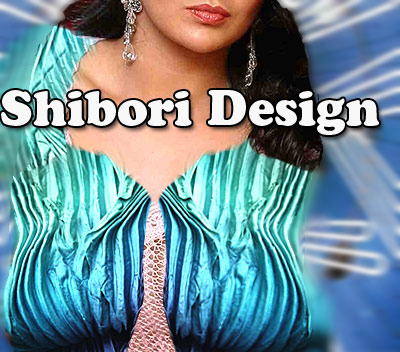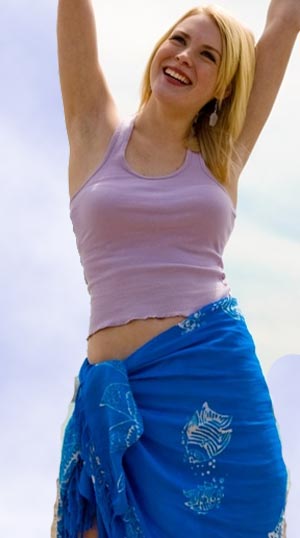Shibori Design Techniques

Tie and dye and resist-dyeing techniques are used in different parts of the world. Shibori is the Japanese art of covering a section of cloth to resist absorption of dye or oxidation. This provides relief for the fabric; different methods being used to create seepage and edge effects in a fabric. It is derived from the Japanese word 'shiboru' which means to squeeze, wring and press.
It was originally the art of the poor as people who could not afford silk and rich cotton material for their garments used this technique extensively. They used to mend their old clothes, dye it repeatedly so as to give it a new look.
In this technique one can fold, bind, stitch, twist or compress a cloth to achieve different patterns using the Shibori dyeing. Each of these methods produces a different effect. But the method is chosen based on the fabric type. It is very important to understand that the technique to be used in Shibori depends on the cloth/fabric as much as it is does on the pattern desired. Each of these techniques can be combined with the other to achieve different patterns and results.
The contemporary method has long replaced the conventional method of Shibori fabric dyeing. Though there are many right methods to achieve results, there is no wrong method in this technique. This flexibility in the technique has given artisans the liberty to modify tools, materials to suit contemporary fashion trends. Shibori dyeing produces free-flowing patterns and no two fabrics are identical.
Shibori dyeing makes any and every fabric colorful and attractive. Caps, bandanas, sheets, tapestries, skirts, pants, socks, shirts - all of these and more can be made using Shibori fabrics. Choose natural fiber fabrics and create patterns on the fabric yardage. Then you can fashion them into clothing or curtains and duvets.
Commonly used Shibori dyeing techniques
Arashi Shibori: Known as pole-wrapping Shibori, the cloth to be dyed is wrapped diagonally around a pole. The cloth is bound very tightly around the pole and is creased on the pole. The result is a pleated cloth with diagonal designs on it. The patterns resemble rain during a storm (Arashi).
Itajime Shibori: The cloth to be dyed is sandwiched between two pieces of wood; the wood is held in place with the help of a string. Shapes cut from acrylic and Plexiglass are also used these days, the shapes being held with C-clamps. The wooden shapes prevent the dye from entering the fabric area that they cover.
Kanoko Shibori: Bound Resist - More like the tie and dye method, binding a few areas of the fabric helps achieve the desired pattern. Thread is used for binding and the pattern that unfolds depends on how tightly the fabric is bound. Many a time, binding is done after folding the cloth. Binding causes random circles.
Kumo Shibori: Pleated and bound resist - The fabric is pleated evenly and finely. The cloth is then bound, resulting in spider-like patterns.
Miura Shibori: Looped binding technique involves using a hooked needle to pluck certain sections of the cloth. A thread is then looped twice around each section. It results in water-like designs; this technique is simple when compared to the other Shibori techniques as the thread is not knotted.
Nui Shibori: Stitch resist - A simple running stitch is used on the cloth which later when pulled tight causes the cloth to gather. The thread need to be pulled very tight and knotted before being dyed. This is a time consuming process but the attractive designs are worth the effort and time spent. You can create exciting patterns with stitches. Straight stitches will show up as perpendicular lines. You can stitch half-concentric circles and create a karamatsu pattern. The design possibilities are plenty.
Suji Shibori: Pleating - Pleats are handmade and a thread is wound around it tightly exposing only the peaks of each of the pleat. The fabric is dyed and the result is a vertical striped pattern. Here it is critical to unfold the material right, without distorting the designs. The dyed cloth then needs to be steamed and stretched.
Top of the Page: Shibori Design Techniques
Tags:#shibori dyeing #shibori designs #shibori technique
 Shopping Guide
Shopping Guide Frugal Shopping Tips
Shopping Bags
Rolling Bags for Shopping
Gym Bag
Women Accessories
Texting Gloves
Women's Wallet
Belt Buckles
Clutch Bags
Women Personal Care
 Clothing Shopping
Clothing Shopping Sleeping Eye Mask
Laptop Backpack
Women's Briefcase
Women's Jacket
Women's Shoes
Summer Footwear Trends
Wide Width Shoes for Women
Women's Flat Shoes
Slippers for Women
Sarong
Summer Shoes
High Heels
Bridal Shoes
Designer Handbag
Outdoor Clothing
Shibori Design Techniques
Batik Fabric
Tie Dye Fabric
Plus Size Swim Wear
Facial Steamers
Stress Relief Products
Gadgets for Women
RFID Technology - RFID Application
Residential Thin Film Solar Panels
Renewable Energy Gadgets
Pepper Spray
Lift Chair
Laptop accessory
Device GPS Tracking
Plasma Television
Polarized Sun Glasses
Home Blood Pressure Monitor
Air Purifier
Car Shopping
Pet Carrier
Brochure Holder
Lanyard
Baby Stroller
Step Pedometer
Jewelry
 Jewelry and Ornaments
Jewelry and Ornaments Coral Jewelry
Replica Watch
Expensive Engagement Rings
Vintage Jewelry
Gifts and Occasions
 Valentine Day Gift Shopping
Valentine Day Gift Shopping Mother Day Gift
Handmade Baby Gift
Gifts under $50
Unusual Gift Ideas for Women
Baby Shower Gift
Unique Housewarming Gifts
Unique Wedding Favor
Winter Wedding Ideas
Holiday Shopping
Holiday Shopping Tips
Christmas Shopping Online Trip
Christmas Decoration Idea
Christmas Gift Gadget
Corporate Christmas Gift Idea
Stocking Stuffers
Christmas Candy Recipe
Currency Conversion
Top of the Page: Shibori Design Techniques
Popularity Index: 101,175

